Stunning wildlife photos capture moments of surprising animal behaviour
Wildlife Photographer of the Year: Unforgettable Behaviour is published by the Natural History Museum.
Over the past 50 years, hundreds of thousands of images have been submitted into the prestigious Wildlife Photographer of the Year competition. Now some of the most memorable have been specially selected for a new book on animal behaviour.
From Amazon river dolphins playing water polo to a plucky penguin, the images capture surprising acts of animal behaviour. Each photograph is accompanied by a short story describing the circumstances behind it. Wildlife Photographer of the Year: Unforgettable Behaviour is published by the Natural History Museum. IBTimes UK presents a small selection of the stunning images from the book.
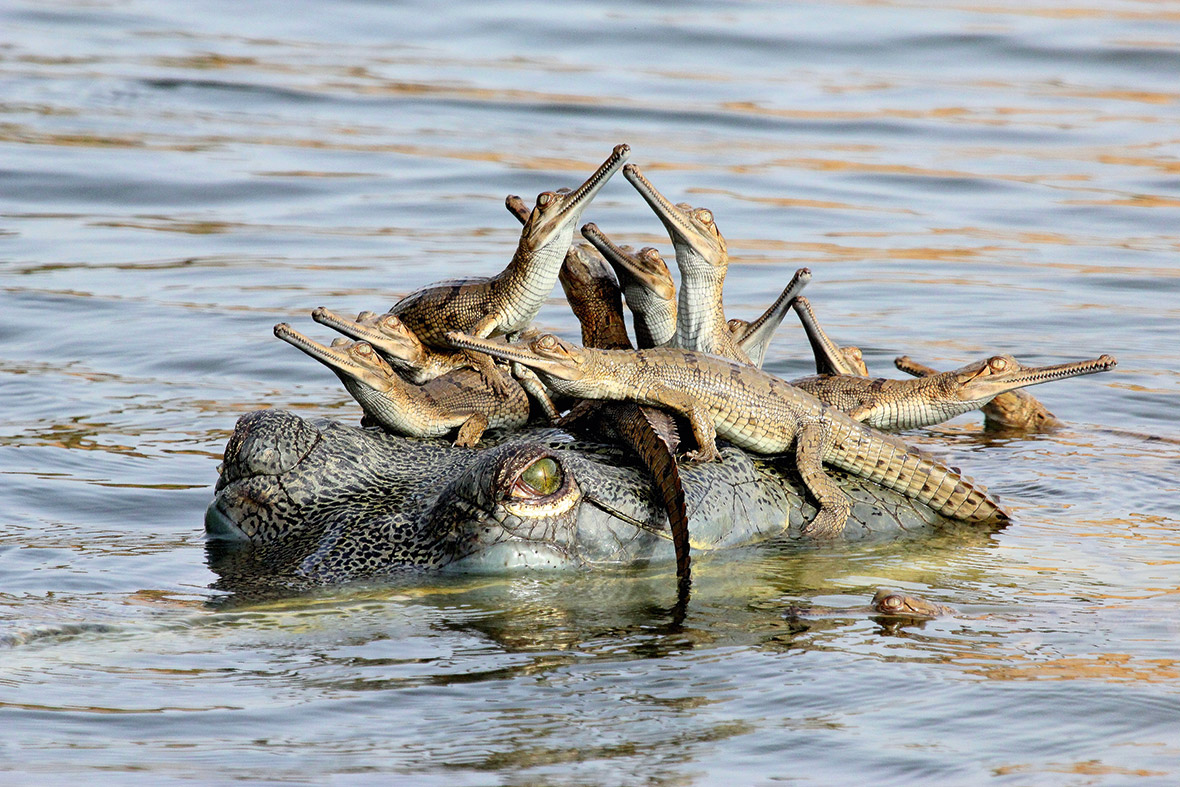




Respect by Igor Shpilenok: When it comes to territory, small predators can be fierce beyond their size. Here the photographer's cat, Ryska – her name means little lynx in Russian – stands outside their cabin and, with aggressive posturing and growling, warns off a fox. In winter, searching for food, foxes would regularly visit the cabin in Kronotsky Nature Reserve in the Russian Far East. If one peered in at the window, which was possible when the snow was deep, Ryska would sit on the other side, fur raised, and growl. When she was outside, she would hold her ground. The foxes were not always frightened, and so encounters could be a sort of dance, but if a fox came too close, Ryska would probably have attacked it. In the wilds of Russia, foxes and domestic cats seldom meet, but in many urban areas of Europe, they encounter regularly at night – and mostly ignore one another. In the UK, a typical fox territory can be occupied by at least 50 cats, some of them heavier than an average-sized fox. There is little evidence that foxes ever kill cats, other than possibly very sick animals or young feral kittens, and if a fight does break out, it is almost always when a territorial cat attacks the fox, which invariably flees. In fact, it is usually fox cubs, ever curious, that end up with serious injuries from encounters with cats.
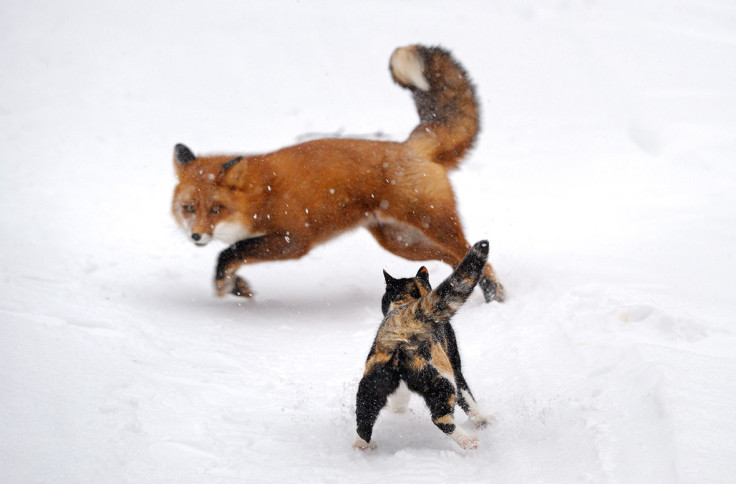
The Penguin Protector by Linc Gasking: A plucky Adélie penguin attempts to drive off a giant petrel menacing a creche of youngsters. The chicks have gathered together for protection while their parents are at sea finding food. If a giant petrel or skua threatens them, any adults nearby will try to drive it away. In the photograph, the giant petrel – a rare white morph of the normally brown southern giant petrel – appears smaller than it actually is because of the perspective. It is really larger than the squawking, flipper-waving Adélie and is capable of dragging off and pecking to death a young penguin. Usually, though, southern giant petrels act like vultures at the penguin and seal-breeding colonies, feeding on the carcasses of the many young that perish. But when carrion is not available, they will pick off any young chicks that become separated from their parents or an older chick at the edge of a huddle. These defensive creches form when Adélie chicks get to be 20–30 days old and both parents are at sea, and the size of a creche depends on how many adult neighbours are around to drive off predators. At this age, the chicks are relatively safe from their mainland predator, the south polar skua, which is smaller than a giant petrel and will seldom attack a large chick. But the chicks' problems aren't over even after they fledge. When they enter the sea for the first time, they have to run the gauntlet of leopard seals that lurk offshore, waiting to pick off the unwary.

Boto Ball Play by Kevin Schafer: This is possibly pure showing-off. A male Amazon river dolphin, or boto, is throwing around a macucu nut, watched by other botos, mainly males but possibly including a female. The photographer watched botos playing with objects many times, most often in the afternoon, and to shoot the behaviour from above, built a floating platform over a tributary of the Rio Negro in Amazonian Brazil. Though females have been seen playing with objects, ball‑throwing seems to occur mainly among groups of adult males as a sort of aggressive competition. Any object will do, a branch, a ball of mud or even a turtle. These botos are in tannin-rich water and so appear orange, but as the nose of the ball‑thrower reveals, they are actually pale-skinned, and depending on their age and sexual arousal, males can be bright pink. The largest of the world's river dolphins, botos can be 2.5 metres (more than 8 feet) long and capable of catching large fish with their long jaws, which are also useful for winkling prey out of hiding. Unlike marine dolphins, a boto's neck vertebrae are unfused, allowing it to turn its head from side to side. In the flooded forest where it hunts, this flexibility enables it to swim around tree roots – and, of course, throw "balls".
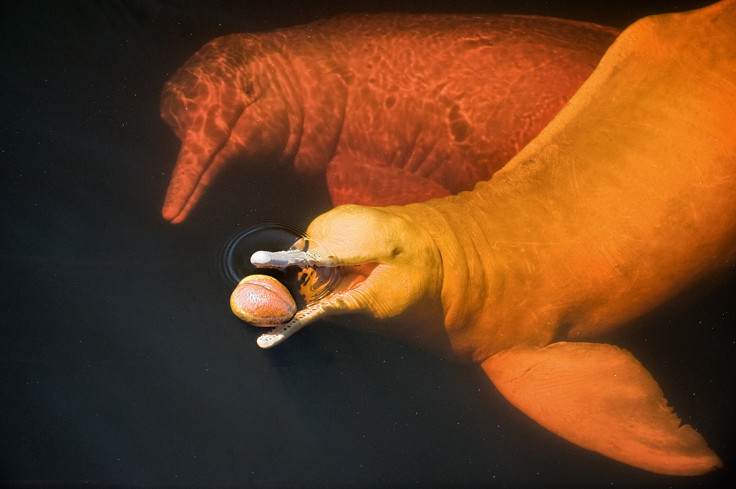
When the Lion Lies Down with the Foal by Adrian Bailey: A lion embraces a zebra foal. The foal is not injured and is being held gently. But all is not what it seems. The lion took the foal after it became separated from its herd, which was moving on migration through the lions' territory in Chobe National Park, Botswana. When the picture was taken, there was just one lioness nearby, but not long after, the rest of the pride arrived just as the foal got up and started to move away. Within minutes it had been caught and killed. The likelihood is that the lion was merely playing with its feeble young prey and had lost interest in it for a while; had the foal struggled, it might have been killed sooner. Very young antelopes that haven't yet developed the flight instinct are sometimes taken by lions and respond to their predators as protectors, behaviour which stops them being killed, at least for a while. There are, however, rare instances of lionesses taking the young of their prey animals and keeping them alive for days or even weeks. A famous case occurred in northern Kenya in 2004, in Samburu National Park, where a lioness caught a young oryx calf and adopted it, allowing it to curl up and rest beside her and protecting it from other predators. In fact, she caught calves five times, each time looking after the baby as if it were her cub, following it everywhere and even preventing it from making contact with other oryx. The first calf lasted two weeks before being killed by a lion when the lioness was asleep. The second, third and fourth were removed by rangers. The last, a newborn, finally died of starvation. The reason for such unusual, obsessive behaviour was possibly trauma – the lioness having become separated from her pride, possibly even her own cubs – and the young oryx probably gave her comfort.
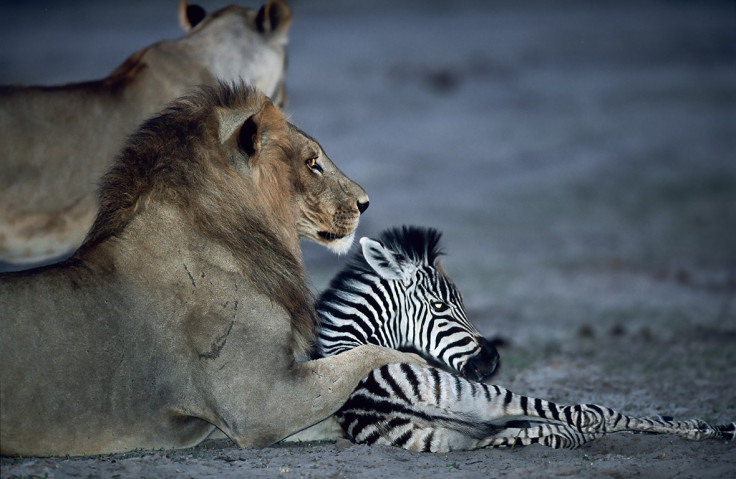
A Little Swinger by Thomas Vijayan: It's the end of the day, and a group of black-footed grey langurs are settling into a tree, ready for the night. But this infant has decided it's playtime. Swinging on the tails of two juveniles – seemingly unconcerned by his antics – he is making a characteristic play face. Eventually he falls off, but immediately climbs back up the tree and starts the game all over again, swinging another four times before finishing the session. His mother takes little notice of the activity, and the adolescents tolerate the attention-seeking acrobatics. Langurs are very social, and youngsters play as often as they can. But they do so less frequently when leaves and other plant material are not plentiful and feeding becomes all-important. Infants will play with older youngsters and subadults, but adults seldom join in. Acrobatic play is probably a way of practising tree-living and helps develop bone and muscle. But play also develops social bonds and communication skills, and the choice of play partner is important. Wrestling play is common and a way of sorting out who is dominant and learning the social dynamics of tolerance, cooperation and fairness; juveniles are very tolerant of infants and will let them take the lead and learn the signals and rules that stop play escalating into fighting. Young langurs even play at grooming, which is an essential part of social bonding. One theory about the need for play is that, among big-brained species, it is essential for brain development. Play is common only among mammals – though highly intelligent birds such as parrots and corvids (the crow family) also play – and there seems to be a relationship between the size of the brain and the amount of play. The suggestion is that the stimulation provided by play may actually mould the brain's architecture.
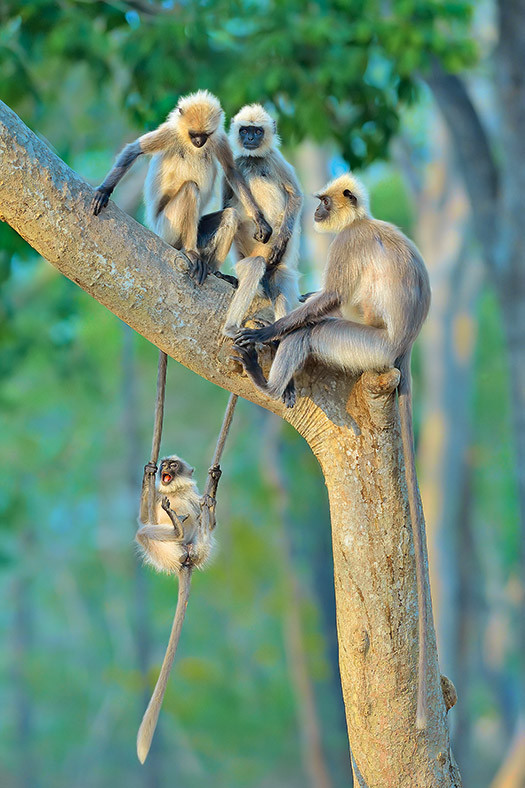
Mother's Little Headful by Udayan Rao Pawar: It's early morning in central India's Chambal River, and a large female gharial is hanging in the water offshore. The babies that have swum out to her are using her huge head as an island, taking advantage of the safe basking perch. The female is one of a colony of gharials that have nested communally at this traditional riverbank site. The mothers stood guard over the nests and then, alerted by the grunting of the emerging babies, excavated them when the eggs started to hatch. But now they are keeping watch from the river, with this female acting as chief guard for 100 or so hatchlings. She and the other mothers, and a few males, presumably fathers, will protect the young for at least a month or more until the monsoon rains arrive and they move down the river to feed in deeper water (floodwater may also sweep the young downstream). They will keep watch for predators such as jackals and monitor lizards after the young, though unlike other crocodiles, they can't raise their bodies off the ground and give chase. Instead they have to push and slide themselves ashore. The Chambal River is the last stronghold of this fish-eating crocodile, once found in rivers throughout the Indian subcontinent but devastated by past hunting and then irreversible changes to their rivers caused by dams, canals, irrigation and other developments. Now critically endangered, gharials are still under pressure, mainly from illegal sand‑mining in their nesting areas and illegal fishing, but also from egg collection, pollution and water extraction – they need unobstructed, free‑flowing rivers. Gharials don't mature until they are 10 years old, and today, of the estimated 1,400 adults that survive, the most important breeding population is in the Chambal River. So these youngsters are indeed a precious little headful.
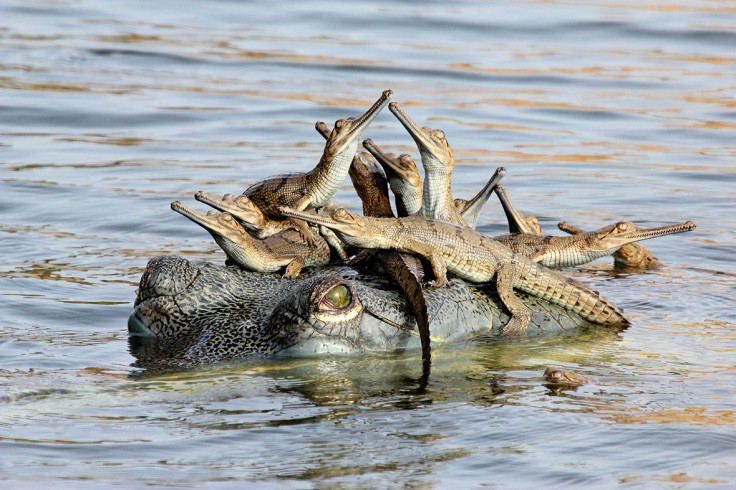
Salmon Swipe by Paul Souders: In a pool below rapids, along a small river running down to Kuliak Bay in Alaska's Katmai National Park, a female grizzly bear fishes for salmon. The salmon are gathering before attempting to leap the rapids and continue upstream to spawn. In late summer, most of the grizzlies in this southern Alaskan wilderness area congregate along the rivers to feast on the salmon returning from the Pacific to their natal streams. This female was experienced at fishing, using different techniques depending on the depth of the water. Here she is swimming above a shoal of chum salmon, trying to scoop them out with her massive clawed paws. Many grizzlies in Canada and Alaska depend on the autumn run of fat‑rich salmon to put on enough weight for winter hibernation and, for the females, to build up enough reserves to bear young and suckle them through the spring. Though grizzlies can survive on a mainly herbivorous diet, those bears that have access to salmon need smaller home ranges, gain weight faster, grow larger and rear more young. The ecosystems alongside the rivers are also moulded by the salmon, which fertilize the soil through the scraps and dung left by the bears that feast on them.

The Stampede by Eric Pierre: Muskoxen stampeding over flat, frozen tundra, thunder towards the photographer. This is not normal behaviour for these Arctic animals, unless a pack of wolves is chasing them. With their extreme insulation – dense underwool and a thick blanket of long hair – they can overheat if forced to run far, and their usual defence is to face a predator. If a lone bull is threatened, it may charge, and bulls have been known to kill people who encroach on their space. But as social animals, the more common reaction of muskoxen to a predator is to group together and face it in a line. Both sexes have upwardly curved, pointed horns, used for impaling and throwing attackers, whether wolves or bears. If they are attacked by a pack of wolves, the group forms a compact circle, all facing out and with calves in the centre. Larger adults may charge out to try to head-butt or hook a wolf and trample it (males have particularly broad 'bosses' above their horns that absorb the shock of a head-clash). But what the wolves want to do is to spook the muskoxen and make them run, knowing that the younger and weaker animals will trail behind and can be picked off by the pack. In this case, the photographer was following Arctic wolves on Canada's Victoria Island. Being careful not to spook the muskoxen, he had deliberately made a detour upwind and was half a kilometre (a third of a mile) away when they started to run, unaware of his presence ahead. Unfortunately, though, the most usual cause of a stampede is a human one – a low‑flying plane or helicopter or a skidoo.
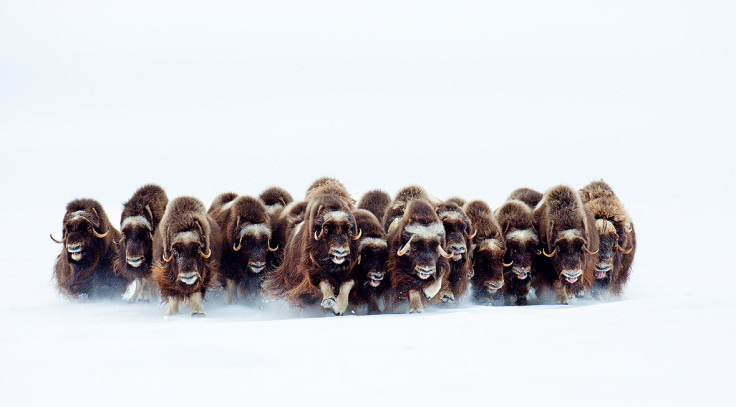
Crèche Call Up by Darío Podestá: A young Patagonian mara presents its bottom to its mother so she can sniff its identity. She has whistled the brood out of the communal den on the southern plains of Argentina and is checking which are her twins. Once she's identified them, by size as well as scent, she will suckle them nearby, fending off the other hungry youngsters. She's accompanied by her mate, who sticks close to her and keeps watch for predators. The rest of the crèche have to wait for the daily visit of their own parents. They keep close to the den and go to ground immediately if an adult warns that an eagle or fox is about. More than 20 pairs have been known to den together. The more that do so, the greater the survival rate of the young, perhaps because there will almost always be one pair in attendance and therefore adults on guard. And if any young are orphaned, they have a chance of suckling from the other mothers. Such crèche denning is unique among mammals. On the plains, it's a way to keep the youngsters safe for their first few weeks, until they are old enough to follow their parents on feeding forays. Patagonian maras are giant rodents – that is, related to guinea pigs, not rabbits – found only in Argentina. Not only is their breeding system unusual, but unlike most other mammals, they pair for life, the male following the female everywhere as they search for grazing, scanning for predators as she feeds. They are fast runners and need to be as they are prey to predators from foxes to pumas. Like gazelles, if they spot a predator, they use an exaggerated bounding gait that advertises that they are fit and not worth the chase.
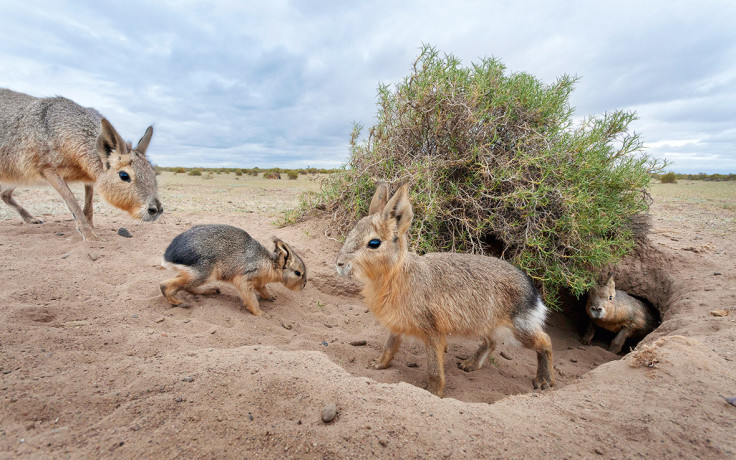
Big Chipper by Benjam Pöntinen: With a sideways flourish, the black woodpecker tosses out woodchips from the nest hole he has been fashioning. He has been at it for the past two weeks, since early March. The ground below is littered with large woodchips – an obvious sign that Europe's biggest woodchipper is at work here in Finland. The hole – 7 metres (23 feet) up the pine tree – is a major excavation, probably extending 60 centimetres (2 feet) down into the trunk. The amount of head‑pounding hammer‑drilling involved would cause significant trauma to the brain if the woodpecker's head didn't include elasticated tissue between beak and skull, spongy shock-absorber skull-plate bones and a special hyoid bone that diverts vibrations and acts as a safety belt. Its chisel-like beak has a high-strength inner layer of bone and a flexible outer layer that helps reduce the shock of the vibrations and keeps growing so the beak doesn't wear down. Bristles keep the sawdust out of its narrow nostrils, and thick nictitating membranes close over the eyes at the moment of hammering. If the female finds the nest chamber to her satisfaction, she will lay two to eight eggs, which the pair take turns incubating (at the changeover, they will communicate by drumming, inside and outside the hole). The oval entrance hole is a perfect fit for the woodpeckers, but it is also large enough for a pine marten to squeeze into and eat the eggs, chicks or even a brooding woodpecker. The risk of a pine marten returning to a nest hole the following year may explain why a black woodpecker usually starts a new one every year.
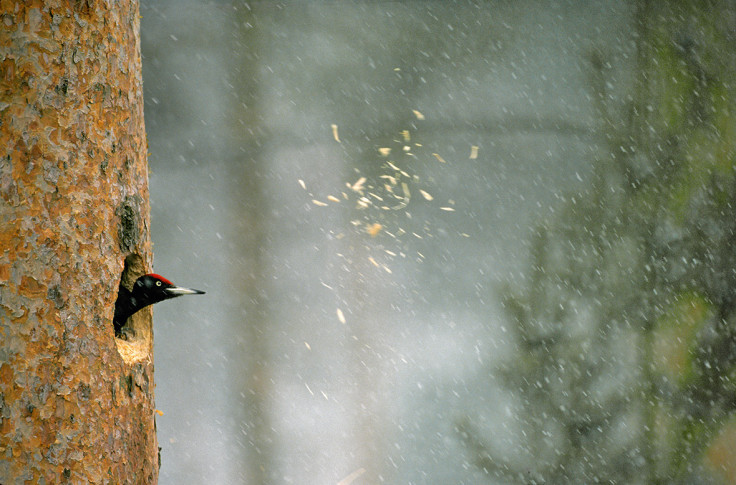
The Wildlife Photographer of the Year exhibition runs until 10 Sept 2017 at the Natural History Museum, London. See our gallery of the winning images here.
© Copyright IBTimes 2025. All rights reserved.






















